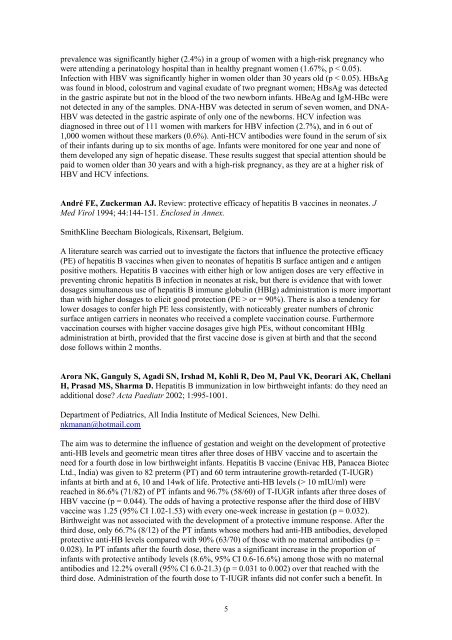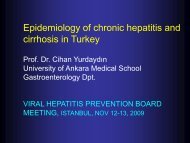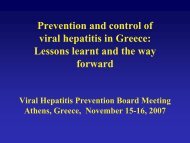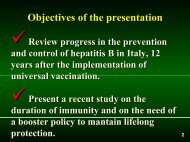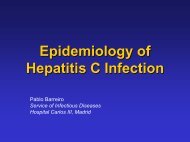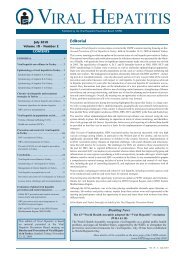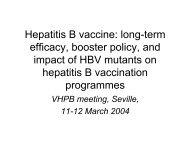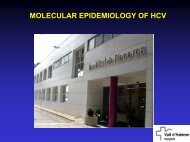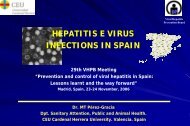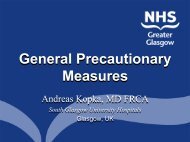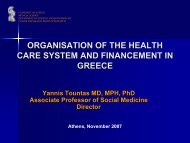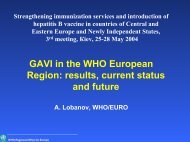Ahn YO. Strategy for vacc<strong>in</strong>ation aga<strong>in</strong>st <strong>hepatitis</strong> B <strong>in</strong> areas with high endemicity: focus onKorea. Gut 1996; 38(Suppl 2):S63-S66.Department <strong>of</strong> Preventive Medic<strong>in</strong>e, Seoul National University College <strong>of</strong> Medic<strong>in</strong>e, Korea.Hepatitis B vacc<strong>in</strong>ation strategies may vary from country to country depend<strong>in</strong>g on <strong>hepatitis</strong> B<strong>virus</strong> (HBV) endemicity, predom<strong>in</strong>ant modes <strong>of</strong> <strong>in</strong>fection, age <strong>of</strong> <strong>in</strong>fection, <strong>and</strong> health careresources. In areas with high endemicity like Korea, <strong>transmission</strong> <strong>of</strong> <strong>virus</strong> from carrier mothers to<strong>in</strong>fants dur<strong>in</strong>g the <strong>per<strong>in</strong>atal</strong> period, <strong>and</strong> from other horizontal sources to <strong>in</strong>fants <strong>and</strong> children,account for most cases <strong>of</strong> HBV <strong>in</strong>fection. The consequences <strong>of</strong> HBV <strong>in</strong>fection at an early age areserious, as more than 70% rema<strong>in</strong> chronic carriers <strong>of</strong> the <strong>virus</strong>. These chronic carriers are thepr<strong>in</strong>cipal source <strong>of</strong> <strong>in</strong>fection for other susceptible people, <strong>and</strong> are themselves at high risk <strong>of</strong>develop<strong>in</strong>g other serious diseases, such as chronic <strong>hepatitis</strong>, liver cirrhosis, <strong>and</strong> hepatocellularcarc<strong>in</strong>oma. Theoretically, therefore, rout<strong>in</strong>e <strong>in</strong>fant immunisation supplemented with prenatalscreen<strong>in</strong>g <strong>of</strong> pregnant women for HBsAg or HBeAg <strong>and</strong> mass immunisation <strong>of</strong> children is theappropriate strategy for <strong>control</strong> <strong>of</strong> <strong>hepatitis</strong> B <strong>in</strong> these countries. To prevent primary liver cancerassociated with HBV <strong>in</strong>fection, however, immunisation <strong>of</strong> adults at high risk would also beprudent. M<strong>and</strong>atory vacc<strong>in</strong>ation <strong>of</strong> all neonates is recommended <strong>in</strong> highly endemic areas, togetherwith <strong>hepatitis</strong> B immune globul<strong>in</strong> <strong>in</strong> babies born to HBsAg carrier mothers.Aiken KD, Clark SJ, Cabana MD. Reasons hospitals give for not <strong>of</strong>fer<strong>in</strong>g <strong>hepatitis</strong> B vacc<strong>in</strong>e tolow-risk newborns. Cl<strong>in</strong> Pediatr (Phila) 2002; 41:681-686.Child Health Evaluation <strong>and</strong> Research Unit, Division <strong>of</strong> General Pediatrics, University <strong>of</strong>Michigan Health System, Ann Arbor, Michigan 48109-0718, USAAfter a temporary suspension <strong>of</strong> <strong>hepatitis</strong> B vacc<strong>in</strong>ation (HBV) for low-risk newborns <strong>in</strong> July1999, some hospitals still do not <strong>of</strong>fer HBV to these <strong>in</strong>fants. A semi-structured telephone survey <strong>of</strong>medical directors from a national r<strong>and</strong>om sample <strong>of</strong> 296 hospital nurseries was completed fromAugust 2000 to April 2001 <strong>and</strong> analyzed us<strong>in</strong>g qualitative techniques. Directors <strong>of</strong> 201 <strong>of</strong> 290eligible nurseries (71%) participated. Twenty-ight nurseries have never <strong>of</strong>fered HBV to low-risknewborns (‘Never Offered HBV’) <strong>and</strong> 37 nurseries had <strong>of</strong>fered HBV to low-risk newborns beforeJuly 1999, but discont<strong>in</strong>ued this practice after the temporary suspension (‘Discont<strong>in</strong>ued HBV’).Common reasons for not <strong>of</strong>fer<strong>in</strong>g HBV to low-risk newborns were difficulty with reimbursement<strong>and</strong> convenience <strong>of</strong> outpatient adm<strong>in</strong>istration. In addition, directors <strong>of</strong> ‘Never Offered HBV’nurseries cited low disease <strong>in</strong>cidence <strong>in</strong> their patient population, whereas directors <strong>of</strong>‘Discont<strong>in</strong>ued HBV’ cited preference for the comb<strong>in</strong>ation <strong>hepatitis</strong> B - Haemophilus <strong>in</strong>fluenzatype b vacc<strong>in</strong>e as important factors. Multi-faceted <strong>in</strong>terventions may be necessary to <strong>in</strong>crease HBVuse <strong>in</strong> the nursery.Alvarez-Muñoz MT, Vázquez-Rosales JG, Torres-López FJ, Arredondo-García JL,Bustamante-Calvillo ME, Del Rey-P<strong>in</strong>eda G, Garduno-Esp<strong>in</strong>osa J, Muñoz-Hern<strong>and</strong>ez O.Infection <strong>of</strong> pregnant women with <strong>hepatitis</strong> B <strong>and</strong> C <strong>virus</strong>es <strong>and</strong> risks for vertical <strong>transmission</strong>.Arch Med Res 1997; 28:415-419.Unidad de Investigacion Medica en Enfermedades Infecciosas y Parasitarias, Coord<strong>in</strong>acion deInvestigacion Medica, IMSS, Mexico, D.F.Pregnant women <strong>in</strong>fected with <strong>hepatitis</strong> B <strong>and</strong> C <strong>virus</strong>es pose a risk for <strong>in</strong>fect<strong>in</strong>g their newborn<strong>in</strong>fants by vertical <strong>transmission</strong>. We studied 6,253 pregnant women aged 12-49 years for <strong>in</strong>fectionwith <strong>hepatitis</strong> B (HBV) <strong>and</strong> C (HCV) <strong>virus</strong>es. Infection was diagnosed by measur<strong>in</strong>g IgGantibodies aga<strong>in</strong>st HBc, HBs, HBe, as well as IgM-HBc <strong>and</strong> HCV viral antigens withcommercially available immunoassay kits. HBV <strong>in</strong>fection was detected <strong>in</strong> 113 cases (1.8%), <strong>and</strong>4
prevalence was significantly higher (2.4%) <strong>in</strong> a group <strong>of</strong> women with a high-risk pregnancy whowere attend<strong>in</strong>g a per<strong>in</strong>atology hospital than <strong>in</strong> healthy pregnant women (1.67%, p < 0.05).Infection with HBV was significantly higher <strong>in</strong> women older than 30 years old (p < 0.05). HBsAgwas found <strong>in</strong> blood, colostrum <strong>and</strong> vag<strong>in</strong>al exudate <strong>of</strong> two pregnant women; HBsAg was detected<strong>in</strong> the gastric aspirate but not <strong>in</strong> the blood <strong>of</strong> the two newborn <strong>in</strong>fants. HBeAg <strong>and</strong> IgM-HBc werenot detected <strong>in</strong> any <strong>of</strong> the samples. DNA-HBV was detected <strong>in</strong> serum <strong>of</strong> seven women, <strong>and</strong> DNA-HBV was detected <strong>in</strong> the gastric aspirate <strong>of</strong> only one <strong>of</strong> the newborns. HCV <strong>in</strong>fection wasdiagnosed <strong>in</strong> three out <strong>of</strong> 111 women with markers for HBV <strong>in</strong>fection (2.7%), <strong>and</strong> <strong>in</strong> 6 out <strong>of</strong>1,000 women without these markers (0.6%). Anti-HCV antibodies were found <strong>in</strong> the serum <strong>of</strong> six<strong>of</strong> their <strong>in</strong>fants dur<strong>in</strong>g up to six months <strong>of</strong> age. Infants were monitored for one year <strong>and</strong> none <strong>of</strong>them developed any sign <strong>of</strong> hepatic disease. These results suggest that special attention should bepaid to women older than 30 years <strong>and</strong> with a high-risk pregnancy, as they are at a higher risk <strong>of</strong>HBV <strong>and</strong> HCV <strong>in</strong>fections.André FE, Zuckerman AJ. Review: protective efficacy <strong>of</strong> <strong>hepatitis</strong> B vacc<strong>in</strong>es <strong>in</strong> neonates. JMed Virol 1994; 44:144-151. Enclosed <strong>in</strong> Annex.SmithKl<strong>in</strong>e Beecham Biologicals, Rixensart, Belgium.A literature search was carried out to <strong>in</strong>vestigate the factors that <strong>in</strong>fluence the protective efficacy(PE) <strong>of</strong> <strong>hepatitis</strong> B vacc<strong>in</strong>es when given to neonates <strong>of</strong> <strong>hepatitis</strong> B surface antigen <strong>and</strong> e antigenpositive mothers. Hepatitis B vacc<strong>in</strong>es with either high or low antigen doses are very effective <strong>in</strong>prevent<strong>in</strong>g chronic <strong>hepatitis</strong> B <strong>in</strong>fection <strong>in</strong> neonates at risk, but there is evidence that with lowerdosages simultaneous use <strong>of</strong> <strong>hepatitis</strong> B immune globul<strong>in</strong> (HBIg) adm<strong>in</strong>istration is more importantthan with higher dosages to elicit good protection (PE > or = 90%). There is also a tendency forlower dosages to confer high PE less consistently, with noticeably greater numbers <strong>of</strong> chronicsurface antigen carriers <strong>in</strong> neonates who received a complete vacc<strong>in</strong>ation course. Furthermorevacc<strong>in</strong>ation courses with higher vacc<strong>in</strong>e dosages give high PEs, without concomitant HBIgadm<strong>in</strong>istration at birth, provided that the first vacc<strong>in</strong>e dose is given at birth <strong>and</strong> that the seconddose follows with<strong>in</strong> 2 months.Arora NK, Ganguly S, Agadi SN, Irshad M, Kohli R, Deo M, Paul VK, Deorari AK, ChellaniH, Prasad MS, Sharma D. Hepatitis B immunization <strong>in</strong> low birthweight <strong>in</strong>fants: do they need anadditional dose? Acta Paediatr 2002; 1:995-1001.Department <strong>of</strong> Pediatrics, All India Institute <strong>of</strong> Medical Sciences, New Delhi.nkmanan@hotmail.comThe aim was to determ<strong>in</strong>e the <strong>in</strong>fluence <strong>of</strong> gestation <strong>and</strong> weight on the development <strong>of</strong> protectiveanti-HB levels <strong>and</strong> geometric mean titres after three doses <strong>of</strong> HBV vacc<strong>in</strong>e <strong>and</strong> to ascerta<strong>in</strong> theneed for a fourth dose <strong>in</strong> low birthweight <strong>in</strong>fants. Hepatitis B vacc<strong>in</strong>e (Enivac HB, Panacea BiotecLtd., India) was given to 82 preterm (PT) <strong>and</strong> 60 term <strong>in</strong>trauter<strong>in</strong>e growth-retarded (T-IUGR)<strong>in</strong>fants at birth <strong>and</strong> at 6, 10 <strong>and</strong> 14wk <strong>of</strong> life. Protective anti-HB levels (> 10 mIU/ml) werereached <strong>in</strong> 86.6% (71/82) <strong>of</strong> PT <strong>in</strong>fants <strong>and</strong> 96.7% (58/60) <strong>of</strong> T-IUGR <strong>in</strong>fants after three doses <strong>of</strong>HBV vacc<strong>in</strong>e (p = 0.044). The odds <strong>of</strong> hav<strong>in</strong>g a protective response after the third dose <strong>of</strong> HBVvacc<strong>in</strong>e was 1.25 (95% CI 1.02-1.53) with every one-week <strong>in</strong>crease <strong>in</strong> gestation (p = 0.032).Birthweight was not associated with the development <strong>of</strong> a protective immune response. After thethird dose, only 66.7% (8/12) <strong>of</strong> the PT <strong>in</strong>fants whose mothers had anti-HB antibodies, developedprotective anti-HB levels compared with 90% (63/70) <strong>of</strong> those with no maternal antibodies (p =0.028). In PT <strong>in</strong>fants after the fourth dose, there was a significant <strong>in</strong>crease <strong>in</strong> the proportion <strong>of</strong><strong>in</strong>fants with protective antibody levels (8.6%, 95% CI 0.6-16.6%) among those with no maternalantibodies <strong>and</strong> 12.2% overall (95% CI 6.0-21.3) (p = 0.031 to 0.002) over that reached with thethird dose. Adm<strong>in</strong>istration <strong>of</strong> the fourth dose to T-IUGR <strong>in</strong>fants did not confer such a benefit. In5
- Page 1 and 2: Pre-meeting documentPrevention and
- Page 3: Part I Prevention and control of pe
- Page 7 and 8: clusters (obstetrics wards/hospital
- Page 9 and 10: Boxall E. Screening of pregnant wom
- Page 11 and 12: Chang MH, Hsu HY, Huang LM, Lee PI,
- Page 13 and 14: of infection in infants and childre
- Page 15 and 16: Eriksen EM, Perlman JA, Miller A, M
- Page 17 and 18: liver enzyme abnormalities than wer
- Page 19 and 20: health care, is feasible and achiev
- Page 21 and 22: HBsAg and anti-HBs in 4.5%. In the
- Page 23 and 24: immunoprophylaxis. Reflecting effec
- Page 25 and 26: Levin CE, Nelson CM, Widjaya A, Mon
- Page 27 and 28: Delaying vaccination of premature i
- Page 29 and 30: diagnosis. In the past, the inciden
- Page 31 and 32: shows that the prevalence of HBV in
- Page 33 and 34: Niu MT, Targonski PV, Stoll BJ, Alb
- Page 35 and 36: Ranger-Rogez S, Alain S, Denis F. H
- Page 37 and 38: vaccinees) and low reactogenicity o
- Page 39 and 40: single ELISA test is about Rs40. At
- Page 41 and 42: newborns with surface antigenemia,
- Page 43 and 44: Wang Z, Zhang J, Yang H, Li X, Wen
- Page 45 and 46: of hepatitis B vaccine. This study
- Page 47 and 48: transmission has been estimated at
- Page 49 and 50: at birth and 2 weeks after birth, f
- Page 51 and 52: Chubinishvili OV, Mikhailov MI, Sak
- Page 53 and 54: Jensen L, Heilmann C, Smith E, Want
- Page 55 and 56:
Onishchenko GG. Incidence of infect
- Page 57:
Zanetti A, Tanzi E, Semprini AE. He


